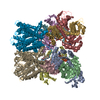[English] 日本語
 Yorodumi
Yorodumi- EMDB-38478: Potassium transporter KtrAB from Bacillus subtilis in ATP-bound s... -
+ Open data
Open data
- Basic information
Basic information
| Entry |  | |||||||||
|---|---|---|---|---|---|---|---|---|---|---|
| Title | Potassium transporter KtrAB from Bacillus subtilis in ATP-bound state with addition of EDTA and EGTA, C1 symmetry | |||||||||
 Map data Map data | ||||||||||
 Sample Sample |
| |||||||||
 Keywords Keywords | KtrAB / RCK /  potassium / potassium /  transporter / transporter /  TRANSPORT PROTEIN TRANSPORT PROTEIN | |||||||||
| Function / homology |  Function and homology information Function and homology informationpotassium:chloride symporter activity / monoatomic cation transmembrane transporter activity / potassium ion transport / identical protein binding /  plasma membrane plasma membraneSimilarity search - Function | |||||||||
| Biological species |   Bacillus subtilis (bacteria) Bacillus subtilis (bacteria) | |||||||||
| Method |  single particle reconstruction / single particle reconstruction /  cryo EM / Resolution: 3.0 Å cryo EM / Resolution: 3.0 Å | |||||||||
 Authors Authors | Chang YK / Chiang WT / Hu NJ / Tsai MD | |||||||||
| Funding support |  Taiwan, 1 items Taiwan, 1 items
| |||||||||
 Citation Citation |  Journal: Nat Commun / Year: 2024 Journal: Nat Commun / Year: 2024Title: Structural basis and synergism of ATP and Na+ activation in bacterial K+ uptake system KtrAB Authors: Chiang WT / Chang YK / Hui WH / Chang SW / Liao CY / Chang YC / Chen CJ / Wang WC / Lai CC / Wang CH / Luo SY / Huang YP / Chou SH / Horng TL / Hou MH / Muench SP / Chen RS / Tsai MD / Hu NJ | |||||||||
| History |
|
- Structure visualization
Structure visualization
| Supplemental images |
|---|
- Downloads & links
Downloads & links
-EMDB archive
| Map data |  emd_38478.map.gz emd_38478.map.gz | 203.9 MB |  EMDB map data format EMDB map data format | |
|---|---|---|---|---|
| Header (meta data) |  emd-38478-v30.xml emd-38478-v30.xml emd-38478.xml emd-38478.xml | 22 KB 22 KB | Display Display |  EMDB header EMDB header |
| FSC (resolution estimation) |  emd_38478_fsc.xml emd_38478_fsc.xml | 13.3 KB | Display |  FSC data file FSC data file |
| Images |  emd_38478.png emd_38478.png | 106.2 KB | ||
| Masks |  emd_38478_msk_1.map emd_38478_msk_1.map | 216 MB |  Mask map Mask map | |
| Filedesc metadata |  emd-38478.cif.gz emd-38478.cif.gz | 6.6 KB | ||
| Others |  emd_38478_additional_1.map.gz emd_38478_additional_1.map.gz emd_38478_half_map_1.map.gz emd_38478_half_map_1.map.gz emd_38478_half_map_2.map.gz emd_38478_half_map_2.map.gz | 191.3 MB 200.6 MB 200.6 MB | ||
| Archive directory |  http://ftp.pdbj.org/pub/emdb/structures/EMD-38478 http://ftp.pdbj.org/pub/emdb/structures/EMD-38478 ftp://ftp.pdbj.org/pub/emdb/structures/EMD-38478 ftp://ftp.pdbj.org/pub/emdb/structures/EMD-38478 | HTTPS FTP |
-Related structure data
| Related structure data | 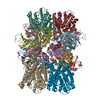 8xmiMC 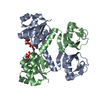 8k16C 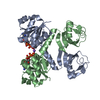 8k1kC 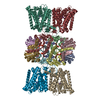 8k1sC 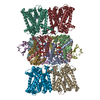 8k1tC 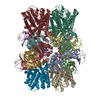 8k1uC 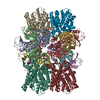 8xmhC M: atomic model generated by this map C: citing same article ( |
|---|---|
| Similar structure data | Similarity search - Function & homology  F&H Search F&H Search |
- Links
Links
| EMDB pages |  EMDB (EBI/PDBe) / EMDB (EBI/PDBe) /  EMDataResource EMDataResource |
|---|---|
| Related items in Molecule of the Month |
- Map
Map
| File |  Download / File: emd_38478.map.gz / Format: CCP4 / Size: 216 MB / Type: IMAGE STORED AS FLOATING POINT NUMBER (4 BYTES) Download / File: emd_38478.map.gz / Format: CCP4 / Size: 216 MB / Type: IMAGE STORED AS FLOATING POINT NUMBER (4 BYTES) | ||||||||||||||||||||
|---|---|---|---|---|---|---|---|---|---|---|---|---|---|---|---|---|---|---|---|---|---|
| Voxel size | X=Y=Z: 0.83 Å | ||||||||||||||||||||
| Density |
| ||||||||||||||||||||
| Symmetry | Space group: 1 | ||||||||||||||||||||
| Details | EMDB XML:
|
-Supplemental data
-Mask #1
| File |  emd_38478_msk_1.map emd_38478_msk_1.map | ||||||||||||
|---|---|---|---|---|---|---|---|---|---|---|---|---|---|
| Projections & Slices |
| ||||||||||||
| Density Histograms |
-Additional map: DeepEMhancer sharpening map
| File | emd_38478_additional_1.map | ||||||||||||
|---|---|---|---|---|---|---|---|---|---|---|---|---|---|
| Annotation | DeepEMhancer sharpening map | ||||||||||||
| Projections & Slices |
| ||||||||||||
| Density Histograms |
-Half map: #2
| File | emd_38478_half_map_1.map | ||||||||||||
|---|---|---|---|---|---|---|---|---|---|---|---|---|---|
| Projections & Slices |
| ||||||||||||
| Density Histograms |
-Half map: #1
| File | emd_38478_half_map_2.map | ||||||||||||
|---|---|---|---|---|---|---|---|---|---|---|---|---|---|
| Projections & Slices |
| ||||||||||||
| Density Histograms |
- Sample components
Sample components
-Entire : Bacillus subtilis KtrAB potassium transporter KtrAB
| Entire | Name: Bacillus subtilis KtrAB potassium transporter KtrAB |
|---|---|
| Components |
|
-Supramolecule #1: Bacillus subtilis KtrAB potassium transporter KtrAB
| Supramolecule | Name: Bacillus subtilis KtrAB potassium transporter KtrAB / type: complex / ID: 1 / Parent: 0 / Macromolecule list: #1-#2 Details: KtrAB complex(chain A-L). KtrAB complex in solution was composed of one KtrA octamer (chain A-H) and two KtrB dimer (chain I-J and chain K-L). The molecule weight of KtrAB complex (chain A-L) is 0.393 MDa |
|---|---|
| Source (natural) | Organism:   Bacillus subtilis (bacteria) Bacillus subtilis (bacteria) |
| Molecular weight | Theoretical: 194 KDa |
-Supramolecule #2: KtrA octamer
| Supramolecule | Name: KtrA octamer / type: complex / ID: 2 / Parent: 1 / Macromolecule list: #1 Details: KtrA ocatmer (chain A-H) The molecule weight of KtrA octamer (chain A-H) is 0.199 MDa. |
|---|---|
| Source (natural) | Organism:   Bacillus subtilis (bacteria) Bacillus subtilis (bacteria) |
-Supramolecule #3: KtrB dimer
| Supramolecule | Name: KtrB dimer / type: complex / ID: 3 / Parent: 1 / Macromolecule list: #2 Details: Two KtrB dimers (chain I-J and chain K-L) The molecule weight of each KtrB dimer is 0.097 MDa |
|---|
-Macromolecule #1: Ktr system potassium uptake protein A
| Macromolecule | Name: Ktr system potassium uptake protein A / type: protein_or_peptide / ID: 1 / Number of copies: 8 / Enantiomer: LEVO |
|---|---|
| Source (natural) | Organism:   Bacillus subtilis (bacteria) Bacillus subtilis (bacteria) |
| Molecular weight | Theoretical: 24.91676 KDa |
| Recombinant expression | Organism:   Escherichia coli (E. coli) Escherichia coli (E. coli) |
| Sequence | String: MGRIKNKQFA VIGLGRFGGS ICKELHRMGH EVLAVDINEE KVNAYASYAT HAVIANATEE NELLSLGIRN FEYVIVAIGA NIQASTLTT LLLKELDIPN IWVKAQNYYH HKVLEKIGAD RIIHPEKDMG VKIAQSLSDE NVLNYIDLSD EYSIVELLAT R KLDSKSII ...String: MGRIKNKQFA VIGLGRFGGS ICKELHRMGH EVLAVDINEE KVNAYASYAT HAVIANATEE NELLSLGIRN FEYVIVAIGA NIQASTLTT LLLKELDIPN IWVKAQNYYH HKVLEKIGAD RIIHPEKDMG VKIAQSLSDE NVLNYIDLSD EYSIVELLAT R KLDSKSII DLNVRAKYGC TILAIKHHGD ICLSPAPEDI IREQDCLVIM GHKKDIKRFE NEGM UniProtKB: Ktr system potassium uptake protein A |
-Macromolecule #2: Ktr system potassium uptake protein B
| Macromolecule | Name: Ktr system potassium uptake protein B / type: protein_or_peptide / ID: 2 / Number of copies: 4 / Enantiomer: LEVO |
|---|---|
| Source (natural) | Organism:   Bacillus subtilis (bacteria) Bacillus subtilis (bacteria) |
| Molecular weight | Theoretical: 48.471539 KDa |
| Recombinant expression | Organism:   Escherichia coli (E. coli) Escherichia coli (E. coli) |
| Sequence | String: MTLQKDKVIK WVRFTPPQVL AIGFFLTIII GAVLLMLPIS TTKPLSWIDA LFTAASATTV TGLAVVDTGT QFTVFGQTVI MGLIQIGGL GFMTFAVLIV MILGKKIGLK ERMLVQEALN QPTIGGVIGL VKVLFLFSIS IELIAALILS IRLVPQYGWS S GLFASLFH ...String: MTLQKDKVIK WVRFTPPQVL AIGFFLTIII GAVLLMLPIS TTKPLSWIDA LFTAASATTV TGLAVVDTGT QFTVFGQTVI MGLIQIGGL GFMTFAVLIV MILGKKIGLK ERMLVQEALN QPTIGGVIGL VKVLFLFSIS IELIAALILS IRLVPQYGWS S GLFASLFH AISAFNNAGF SLWPDNLMSY VGDPTVNLVI TFLFITGGIG FTVLFDVMKN RRFKTFSLHT KLMLTGTLML NA IAMLTVF ILEYSNPGTL GHLHIVDKLW ASYFQAVTPR TAGFNSLDFG SMREGTIVFT LLLMFIGAGS ASTASGIKLT TFI VILTSV IAYLRGKKET VIFRRSIKYP IIIKALAVSV TSLFIVFLGI FALTITEQAP FLQIVFETFS AFGTVGLTMG LTPE LTTAG KCIIIVIMFI GRIGPLTFVF SFAKTEQSNI RYPDGEVFTG UniProtKB: Ktr system potassium uptake protein B |
-Macromolecule #3: ADENOSINE-5'-TRIPHOSPHATE
| Macromolecule | Name: ADENOSINE-5'-TRIPHOSPHATE / type: ligand / ID: 3 / Number of copies: 8 / Formula: ATP |
|---|---|
| Molecular weight | Theoretical: 507.181 Da |
| Chemical component information |  ChemComp-ATP: |
-Macromolecule #4: SODIUM ION
| Macromolecule | Name: SODIUM ION / type: ligand / ID: 4 / Number of copies: 4 |
|---|---|
| Molecular weight | Theoretical: 22.99 Da |
-Macromolecule #5: POTASSIUM ION
| Macromolecule | Name: POTASSIUM ION / type: ligand / ID: 5 / Number of copies: 4 / Formula: K |
|---|---|
| Molecular weight | Theoretical: 39.098 Da |
-Experimental details
-Structure determination
| Method |  cryo EM cryo EM |
|---|---|
 Processing Processing |  single particle reconstruction single particle reconstruction |
| Aggregation state | particle |
- Sample preparation
Sample preparation
| Concentration | 4 mg/mL |
|---|---|
| Buffer | pH: 8 Details: 20 mM Tris-HCl pH 8.0, 70 mM NaCl, 30 mM KCl, 0.75 mM 6-cyclohexyl-1-hexyl-beta-D-maltoside, 2 mM EDTA, 1 mM EGTA, 1 mM ATP |
| Grid | Model: UltrAuFoil R2/2 / Material: GOLD / Mesh: 200 / Support film - Material: GRAPHENE OXIDE / Support film - topology: CONTINUOUS / Pretreatment - Type: GLOW DISCHARGE / Pretreatment - Time: 15 sec. / Pretreatment - Atmosphere: AIR |
| Vitrification | Cryogen name: ETHANE / Chamber humidity: 100 % / Chamber temperature: 277 K / Instrument: FEI VITROBOT MARK IV |
- Electron microscopy
Electron microscopy
| Microscope | FEI TITAN KRIOS |
|---|---|
| Electron beam | Acceleration voltage: 300 kV / Electron source:  FIELD EMISSION GUN FIELD EMISSION GUN |
| Electron optics | Illumination mode: FLOOD BEAM / Imaging mode: BRIGHT FIELD Bright-field microscopy / Nominal defocus max: 2.2 µm / Nominal defocus min: 1.4000000000000001 µm / Nominal magnification: 105000 Bright-field microscopy / Nominal defocus max: 2.2 µm / Nominal defocus min: 1.4000000000000001 µm / Nominal magnification: 105000 |
| Image recording | Film or detector model: GATAN K3 BIOQUANTUM (6k x 4k) / Number grids imaged: 1 / Number real images: 8613 / Average exposure time: 2.0 sec. / Average electron dose: 54.0 e/Å2 |
| Experimental equipment |  Model: Titan Krios / Image courtesy: FEI Company |
 Movie
Movie Controller
Controller










 Z
Z Y
Y X
X


































